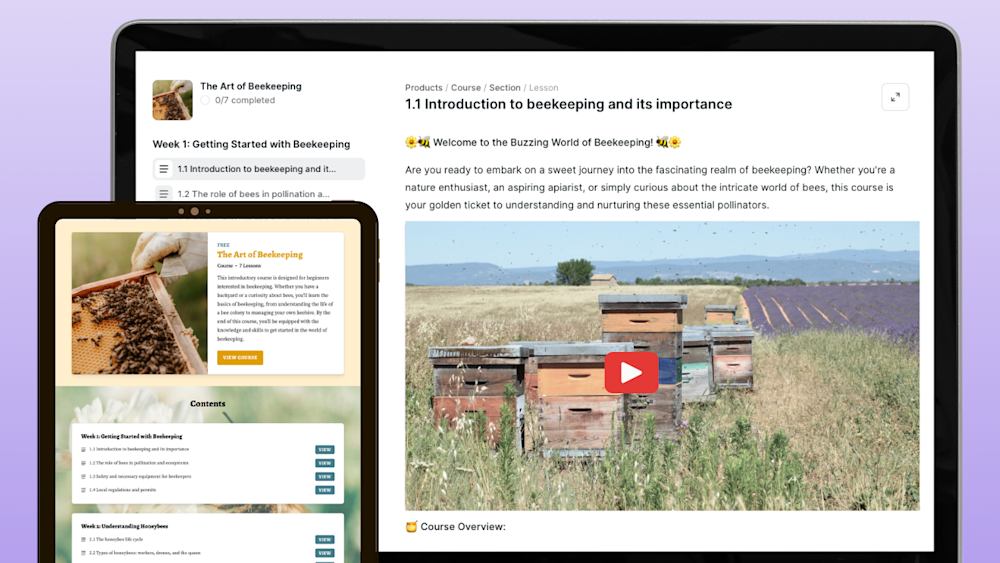As a consumer, having near-limitless choice is amazing.
But as a creator, it’s daunting.
How can you compete with the pros when you don’t feel like an expert or have a beefy marketing budget to back you up?
Start by acknowledging that you are an expert in your niche (even if you don’t yet realize it). Stop letting impostor syndrome dampen your potential, too.
Next, grab your beverage of choice and settle down with this guide to selling online courses in competitive subject areas.
Today, we'll examine several ways you can differentiate yourself and your content from the competition.
But first, let's talk about how to evaluate the landscape in your niche through competitive intelligence.
How to gauge the competition in your niche
“Competitive intelligence” is just a fancy-sounding term for sizing up your competition.
With competitive intelligence, you’re trying to learn as much information as possible about other creators and their online courses before launching your own. This lets you create an amazingly valuable and unique course.
Competitor research can take on many forms, from estimating average monthly search volumes for specific keywords to comparing the language used on two similar websites.
If you’re wondering if competitive intelligence is really worth it, consider this:
The average small business has 17 competitors, and businesses overall have an average of 25 competitors.
Those numbers are even higher if you sell a course in a popular niche, and may increase in the years to come.
What’s more, 48% of businesses say their industry became much more competitive in the last three years.
All this to say, competitors are out there, and if your ideal customers don’t choose you, they have plenty of other options to turn to.
But don’t let that scare you. It’s an opportunity.
Competitor intelligence helps you assess similar businesses, so you can find ways to stand out and win over customers.
To make your competitor research more straightforward and data rich, let’s look to one of the easiest tools to use: Google.
Using Google for competitive intelligence research
Even with dozens of specialized tools to use for competitor research, a humble Google search can tell you heaps about your niche.
After all, Google holds a staggering 69.80% of market share for desktop searches and 93.96% for mobile searches. That’s a lot of data you can extract patterns and information from.
You don’t even have to dredge the depths of Google to find great data, either.
The first page of Google tends to get the most clicks from users around the world, with the first result having an average click-through rate (CTR) of 31.7%.
Let’s take a look at what we can learn from a quick Google search.
The screenshot below shows a search engine results page for the search term “Ruby on Rails tutorials”.
For the sake of this search, we’re using “tutorials” instead of “tutorial” since Ruby on Rails tutorial is a specific educational product. We’re just looking for helpful posts and videos about the programming language.
So, we're not interested in the top three results, which are advertisements.
Let’s skip to the organic results, which are a mixed bag.
Beneath the ads, we see organic results for Ruby on Rails video tutorials.
The first deals with developing web applications in Rails, and the second and third feature content about building a blog with comments using the coding language. We can click the arrow on the third video to see more video results, too.
As for the text-based results, the first link is for Ruby on Rails Tutorial, which we don’t want.
The other results are fairly broad and generic. They don’t give readers a taste of what they’ll learn by clicking each link.
So, what does this mean?
There are two key points to take away from this example.
Firstly, branded search terms like “Ruby on Rails tutorial” can be very hard to compete with. (This also reveals how seemingly generic search terms can reference very specific things.)
The second is that many brands don’t make their article or product’s value immediately clear to those scanning the search engine results page (SERP).
What you can do about it: A fantastic way to distinguish yourself and earn more clicks is by being as specific and informative as possible, particularly in your heading.
Take, for example, SERP results from “learn Spanish online,” which give you two results below.
Which would you rather pick -- the one that claims to be “the world’s best way to learn Spanish” or “Spanish courses online for self-study”?
I’d bet that you and most other searchers out there would click the first result. It makes a bold claim about its quality (being the best). It also indirectly suggests this quality can propel your Spanish studies.
The second result, on the other hand, is generic and sounds like it’s trying to appease a search engine and not a searcher.
Beyond your blog content, use specificity and rich details for your landing pages, product pages, course descriptions, and course content, as well. This backs up your title’s promise and builds your brand’s credibility.
While it may be tempting to use broad product and lesson names to appeal to as many people as possible, this approach puts your content in direct competition with sites that rank better in Google -- and have the marketing budget to solidify their position.
It also makes it harder for prospective students to understand why they should choose your business or course over another.
Specificity is your golden ticket.
Compare Minessa Konecky’s Social Strategy Squad Membership product page as an example.
While many other business coaching product pages go on for days, bursting with buzzwords, Minessa’s product page is concise, value-packed, and tells readers exactly how they’d benefit by joining her membership.
And let’s quickly return to our Ruby on Rails example to see how another successful entrepreneur uses clear language to stand out.
Creator Chris Oliver offers a course on integrating Stripe payments using Ruby on Rails.
As its title suggests, Chris’ course is for developers who want to learn how to integrate online payments using Stripe into an e-commerce system, which means it isn’t for just any developer who wants to learn more about Rails.
What’s more, Chris’ course title makes it crystal clear to students what they’ll learn from the course, increasing the likelihood of the right fit enrolling in it.
At first glance, picking such a specific topic shrinks Chris’ potential audience. But, by having such a focused course, it increases Chris’ chances of converting a hesitant lead into a customer.
Chris solves a unique problem for a unique audience. And chances are, few other instructors are helping developers with this specific problem.
Beyond the title, his lesson library uses descriptive terms like “Testing Stripe with VCR and Webmock” and “Testing Stripe JS with System Tests” to clearly indicate what students will learn.
Breaking down this complex topic into small, manageable lessons makes the course less intimidating, too -- another factor that reduces friction for people considering purchasing his course.
He also includes several testimonials from Rails developers who've taken his course to further establish and build trust.
These details -- a clear title and lesson names, digestible lessons, testimonials, and more -- make Chris’ course infinitely more valuable and distinct than courses offering vague promises to generally teach developers how to use Rails.
By now, we’ve really hammered the point that competitive intelligence helps you find ways to make your courses more valuable to your audience and distinct from competitors.
On top of that, competitive intelligence using Google also helps you identify topics you should cover in your blog articles or course lessons. In other words, it can help you find keywords you should target to rank higher on the SERP.
And ranking higher on SERP is a pretty big deal considering 90.63% of website pages (a.k.a., the ones that don’t rank well on the SERP) get no organic traffic from Google.
With simple keyword research, however, you can increase your SERP ranking and potentially the number of customers you reach.
(If you’re looking for more direction on this topic, you can use these SEO and blogging tips for online course creators and these four simple SEO tips to improve your search engine ranking, as well.)
So, to recap:
Google can help you identify your competitors and make an exponentially more valuable course that will help you stick out and win more customers. Plus, you can get a pulse on the blog and course topics you can use to appeal to your industry.
But while great course content can earn you more sales, you’ll first need to know how to position your online course in order to convert more leads.
Positioning your online course for success
To position your online course for success, make sure your online courses -- and the language you use to discuss it -- deliver the value your potential customers are looking for.
New sales professionals are often taught the “five magic words” to keep in mind during sales calls: “What's in it for me?”
This reminds us that people don't buy for the sake of buying, but rather, they buy to solve specific problems.
As a creator, you’ll want your product pages, product descriptions, marketing content, and more to clearly answer this question of what’s in it for your audience and that you’ll solve their problems.
If you’re wondering how important a product description and its messaging is, mull over this: 87% of consumers said product descriptions were extremely important to their decision-making process.
And another 98% claim they didn’t purchase something because its description was non-existent, incomplete, or incorrect.
This means there’s a lot riding on how you position your course.
For a key ingredient in doing this right, look to the 79% of consumers who will only consider doing business with companies that show they understand and care about them.
What’s the best way to understand and care about your audience and prospective customers?
Listen.
Listening to your customers can endear them to you more than a snappy sales pitch ever could.
On top of that, your sales and product pages should clearly lay out each feature of your course and the outcome your students can expect to gain.
Take successful entrepreneur and creator, Nicole Saidy, and her course on how to Become a UI/UX Designer as an example.
This is an ideal example of a course that's been tailor-made with outcomes in mind. It's right there in the title.
However, that's not the only thing Nicole's course gets right.
Everything about Nicole's course page, from the introductory copy to the overall lesson structure, is designed to appeal to the prospective students' desired outcomes.
In the landing page copy, Nicole acknowledges her audience’s pain point and that she understands transitioning to user experience design can be overwhelming.
She then outlines how her course specifically works and backs up her claims with testimonials from customers.
Everything about Nicole's course is designed to be friendly, reassuring, and relatable—all of which position Nicole's course as a reliable and trustworthy source for students searching for a fix.
Here’s the gist:
To position your course for success, both the marketing and online course content should speak to your customers’ desires and outcomes, which you can pinpoint by asking and listening to your audience.
There’s one more step towards standing out in a crowd, and it involves something most of us aren’t comfortable with -- acknowledging your worth.
Establishing yourself as a trusted expert
You’ll need to establish yourself as a trusted expert and leverage your expertise as a sales tool in order to stand out from the crowd.
One way to position yourself as an expert is by highlighting your professional experiences.
Just like Sally Ann Miller's course, Author Success Blueprint, does, as an example.
Throughout her course page, Sally Ann mentions several achievements and accomplishments that make her a qualified instructor for becoming a successful author. For instance, Sally mentions that she:
-
Is a best-selling author
-
Has spent over 100 hours researching self-publishing
-
Tested various methods with her own book launches
-
Was able to publish her first non-fiction book within 60 days (despite not having huge amounts of free time)
-
Has published eight titles and sold over 25,000 copies
On top of that, although Sally is a best-selling nonfiction author on the Amazon marketplace, she doesn't rely on her accomplishments alone to establish her authority.
She also uses her storytelling skills to make her copy warm, friendly, and relatable.
Sally shares her own doubts about whether she could become an author and also outlines the challenges she faced as a writer with young children.
She also goes on to describe how, on some days, she could only manage to write for 30 minutes while caring for her children, which gives you an even more vivid picture of her previous struggles.
This makes Sally much more relatable as a person and a teacher. Her honesty builds her credibility and also reminds students that they, too, can overcome obstacles on their way to success.
In Sally's case, her story about persisting in the face of adversity and achieving an ambitious goal establishes her as someone who can be trusted to give advice on making it as an author.
Aside from leaning on your accomplishment, there’s another important point to consider for styling yourself as an expert: Being self-taught isn't a bad thing.
In many ways, it can make you seem even more relatable and inspiring to your students.
Besides, presenting yourself as relatable can do wonders to increase trust and loyalty in your brand, which is hugely important for sales.
In fact, 67% of consumers agree that though a good reputation can get them to try a product, unless they trust the company behind the product, they’ll soon stop buying it.
Speaking of trust, another way to build trust among your audience is to feature testimonials from happy customers.
After all, many shoppers find customer reviews to be somewhat or mostly reliable when shopping online.
Plus, a whopping 97% of consumers check product reviews when making buying decisions, and 59% of them will read between one and 10 reviews before buying something.
The main takeaway here is to position yourself as a trusted expert and teacher by being relatable and empathetic to your audience’s needs and pain points.
If that means sharing your trials and struggles, so be it.
And if you highlight your education or business successes, make sure each achievement is also relevant to your audience. Sure, degrees and awards are nice to have, but if they don’t translate into tangible outcomes for your audience, they mean precious little to them.
What matters are the results -- specifically, the results you’re going to deliver and your competitors won’t.
That’s how you compete in a crowded market.
Gain an advantage over the competition
While a little healthy competition is good for everybody, selling online courses in a crowded subject area can be tough.
But, there are proven ways to stay ahead of the curve.
In a nutshell:
-
Use Google to conduct competitor intelligence research, so you can make your product both better than and distinct from the competition.
-
Position your course for success by using it to solve a specific problem for a unique audience.
-
Use your expertise and experiences to empathize with your audience and earn their trust. This will establish yourself as a credible expert and lead to sales.
With these tips and a little tenacity, you’ll shine through the most crowded of industries.
P.S. If you’re missing a reliable platform for managing, marketing, selling, and delivering your online course, you can fix that with this 14-day no-obligation trial. You’ll be amazed by the ease of use.



